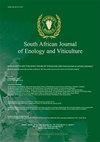葡萄树冠侧缘对皮诺塔奇和赤霞珠葡萄酒感官特性的影响
IF 1.1
4区 农林科学
Q4 FOOD SCIENCE & TECHNOLOGY
引用次数: 4
摘要
葡萄行方向、树冠暴露和葡萄成熟度可以定义葡萄酒的感官属性。从这个角度来看,有利于颜色强度、涩味、香气强度和酸度平衡的树冠暴露可以改善葡萄酒质量。本研究的目的是检验树冠暴露对来自南非帕尔、达班维尔和达令的皮诺塔奇和赤霞珠葡萄酒所选感官特性的影响。Pinotage和赤霞珠葡萄是从种植在东西和南北方向的葡萄树冠两侧收获的。葡萄酒是用收获的葡萄酿造的。葡萄和葡萄酒进行了理化和感官分析。来自南边的德班维尔赤霞珠的酒精含量有所下降。总酸度、残留糖(RS)和pH在两侧之间没有差异。来自东部的葡萄酒颜色、香气、口感和整体质量都有所提高。除了TA外,帕尔赤霞珠的任何理化特性在两侧都没有差异。南部地区的葡萄酒颜色、香气、口感和整体质量都有所提高。Darling Pinotage在任何理化特征方面都没有不同。西侧的葡萄酒香气和酸度都有所增加,而东侧的达班维尔皮诺塔奇葡萄酒的酒精度、pH值、TA、颜色和香气强度以及整体质量都有所增加。研究结果证实,冠层暴露对葡萄酒的感官属性有影响。这项调查说明了皮诺塔奇和赤霞珠葡萄酒在不同树冠侧面的感官属性得分的变化。在特定地区的葡萄园中,树冠暴露在E-W或N-S方向,有利于颜色强度、香气强度和/或口感,可以提高葡萄酒质量。未来的调查应侧重于在至少三个连续年份采集的样本,以及对温度和光合活性辐射的监测。本文章由计算机程序翻译,如有差异,请以英文原文为准。
Effect of Grapevine Canopy Side on Selected Sensory Attributes of Pinotage and Cabernet Sauvignon Wines
Grapevine row direction, canopy exposure and grape maturity can define the sensory attributes of wine. From this perspective, canopy exposure that favours colour intensity, astringency, aroma intensity and balanced acidity could result in improved wine quality. The aim of this study was to examine the effect of canopy exposure on selected sensory attributes of Pinotage and Cabernet Sauvignon wines from Paarl, Durbanville and Darling in South Africa. Pinotage and Cabernet Sauvignon grapes were harvested from both sides of the canopy of vines planted to E-W and N-S directions. Wines were made from the harvested grapes. Grapes and wines underwent physicochemical and sensory analysis. Durbanville Cabernet Sauvignon from the south side had decreased alcohol content. Total acidity, residual sugar (RS) and pH were not different between sides. Wines from the east side had increased colour, aroma, mouthfeel and overall quality. Paarl Cabernet Sauvignon was not different between sides for any physicochemical characteristics, except TA. Wines from the south side had increased colour, aroma, mouthfeel and overall quality. Darling Pinotage was not different between sides for any physicochemical characteristics. Wines from the west side had increased intensity of aroma and acidity, whereas Durbanville Pinotage from the east side had increased alcohol, pH, TA, colour and aroma intensity, as well as overall quality. The results confirm that canopy exposure has an effect on the wine sensory attributes. This investigation illustrates the variation in sensory attribute scores of Pinotage and Cabernet Sauvignon wines from different canopy sides. Canopy exposure in a vineyard of a specific region, orientated to an E-W or N-S direction, which favours colour intensity, aroma intensity and/or mouthfeel, could result in improved wine quality. Future investigations should focus on samples collected over at least three consecutive vintages, as well as the monitoring of temperature and photosynthetic active radiation.
求助全文
通过发布文献求助,成功后即可免费获取论文全文。
去求助
来源期刊
CiteScore
2.50
自引率
7.70%
发文量
1
审稿时长
>36 weeks
期刊介绍:
The South African Journal of Enology and Viticulture (SAJEV) publishes full-length original Research Papers, Research Notes and Review Papers on all subjects related to enology and viticulture. The SAJEV does not accept articles published in, or submitted to, other journals.

 求助内容:
求助内容: 应助结果提醒方式:
应助结果提醒方式:


